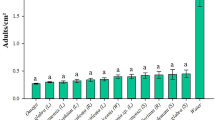Abstract
Pathogenicity of nematophagous fungus Paecilomyces lilacinus (Thom) Samson in control of the most destructive greenhouse pests such as: greenhouse whitefly, Trialeurodes vaporariorum, glasshouse red spider mite, Tetranychus urticae, the cotton aphid, Aphis gossypii and western flower thrips, Frankliniella occidentalis was examined in laboratory and pot experiments. The fungus showed the greatest efficacy in controlling winged and wingless forms of the cotton aphid. The cotton aphid’s population was almost totally eliminated. In controlling the greenhouse whitefly, P. lilacinus was most successful when applied against nymphal growth stages (L3-L4). Control of the western flower thrips was most efficient against prepupal and pupal stages when the fungus was applied as a water spore suspension to the soil. When the fungus was applied at temperatures below 10 °C, it was able to reduce a glasshouse red spider mite population by 60%.
Similar content being viewed by others
References
Amancho A., Sasser J.N. (1995). Biological control of Meloidogyne incognita with Paecilomyces lilacinus. Biocontrol 1: 51–61
Atkins S.D., Clark I.M., Pande S., Hirsch P.R., Kerry B.R. (2005). The use of real-time PCR and species-specific primers for the identification and monitoring of Paecilomyces lilacinus. FEMS Microbiol. Ecol. 51: 257–264
Azaizeh H., Gindin G., Said O., Barash I.(2002). Biological control of the western flower thrips Frankliniella occiden talis in cucumber using the entomopathogenic fungus Metarhizium anisopliae. Phytoparasitica 30 (1): 18–24
Bałazy S. (2000). Zróżnicowanie grup funkcjonalnych grzybów entomopatogenicznych. Biotechnologia 3 (50): 11–32
Benuzzi M., Santopolo F. (2001). Naturalis: a bioinsecticide based on Beauveria bassiana. Informatore – Fitopatologico 51 (4): 61–64
Borisov B.A. (1998). Semi-industrial cultivation of the nematoparasitic fungus Paecilomyces lilacinus (Thom) Samson (Deuteromycotina, Hyphomycetes) and its application against root-knot nematodes in greenhouses. Russ. J. Nematol. 6: 59–60
Borisov B.A., Ushchekov A.T. (1997). Entomofilnye griby – gifomitsety protiv paslenovogo minera. Zashchita i Karantin Rastenij 5: 10–11 (in Russian)
Goodwin S., Steiner M., Enkegaard A.E. (2002). Developments in IPM protected cropping in Australia. Bulletin OILB SROP 25 (1): 81–84
Gökce A., Er M. K. (2005). Pathogenicity of Paecilomyces spp. to the Glasshouse Whitefly, Trialeurodes vaporariorum, with some observations on the fungal infection process. Turkish J. Agric. For. 29(5): 331–339
Jacobson R. J., Chandler D., Fenlon J., Russell K. M. (2001). Compatibility of Beauveria bassiana with Amblyseius cucumeris to control Frankliniella occidentalis on cucumber plants. Biocontrol Sci. Techn. 11(3): 391–400
Jatala P. (1986). Biolgical control of plant parasitic nematodes. Annu. Rev. Phytopathol. 24: 453–489
Neethling D. (2002). The commercialization of Paecilomyces lilacinus as an agent for the control of plant-parasitic nematodes. Nematology 4:154
Pandey R. and P.C. Trivedi, 1990. Biological control of Meloidogyne incognita by Paecilomyces lilacinus in Capsicum annuum. Indian Phytopathology 134–135
Rodriguez-Kabana R., Morgan-Jones G., Goday G., Gintis B.O. (1984). Effectiveness of species of Gliocladium, Paecilomyces and Verticillium for control of Meloidogyne arenaria in field soil. Nematropica 14: 155–170
Samson R.A. (1974). Paecilomycesand some allied hyphomycetes. Stud. Mycol. 6: 1–119
Serman H., Smiths P.H. (2000). Importance of coincidence for the efficiency of the entomopathogenic fungus Verticillium lecanii against Frankliniella occidentalis. Bulletin OILB-SROP 23(2): 223–226
Shipp L., Zhang Y., Hunt D., Ferguson G., Enkegaard A.E. (2002). Influence of greenhouse microclimate on the efficacy of Beauveria bassiana (Balsamo) Vuillemin for control of greenhouse pests. Bulletin OILB-SROP 25(1): 237–240
Silva J.F.V., Piza S.M., Carnerio R.G. (1992). Occurence of Paecilomyces lilacinus infesting eggs of Meloidogyne incognita in the northwest of Parana. Nematologia Brasileira 16: 74–76
Sosnowska D. (2005). Fungi biopesticides in biological control of greenhouse and field pests [in Polish]. Postępy Nauk Rolniczych 5: 17–27
Sosnowska, D. 2001. The role of fungi in reduction of sugar beet nematode (Heterodera schachtii) population. In: “Tri-trophic interactions in the rhizosphere and root-health nematode-fungal-bacterial interrelationships”. IOBC/WPRS Bulletin 24 (1): 151–156.
Sosnowska, D. 2003. Możliwości zastosowania Pochodnia chlamydosporia (Goddard) Zare et Gams oraz Paecilomyces lilacinus (Thom) Samson w biologicznym zwalczaniu mątwika burakowego (Heterodera schachtii Schmidt) i guzaków korzeniowych (Meloidogyne spp.). Rozprawy Naukowe Instytutu Ochrony Roślin, zeszyt 9. 95 pp.
Sosnowska D., Piątkowski J. (1995). Nowy preparat biologiczny do zwalczania mączlika szklarniowego. Ochrona Roślin, 11: 7–9
Sosnowska, D. and J. Piątkowski, 1996. Efficacy of entomopathogenic fungus Paecilomyces fumosoroseus against whitefly (Trialeurodes vaporariorum) in greenhouse tomato cultures. Insect Pathogens and Insect Parasitic Nematodes. Ed.P.H.␣Smits. IOBC WPRS Bulletin, 19 (9): 179–182.
Takayasu S., Akazi M., Shimizu Y. (1977). Cutaneous mycosis caused by Paecilomyces lilacinus. Arch. Dermatol. 113: 1687–1690
van Lenteren, J.C. 2003. Commercial availability of biological control agents. Chapter 11 In: J.C. van Lenteren (ed.), Quality Control and Production of Biological Control Agents: Theory and Testing Procedures. CABI Publishing, Wallingford, UK. pp. 167–179.
Wang L.F., Yang B.J., Li C.D. (2001). Investigation of parasitic fungi on root-knot nematode in East China. Mycosystema 20 (2): 264–267
Zaki F.A. (1994). Effect of culture filtrates of Paecilomyces lilacinus on Meloidogyne javanica. Nematologia Mediterranea 22: 41—43
Acknowledgement
The authors want to thank Prof. J.C. van Lenteren for his comments about the manuscript and for language correction.
Author information
Authors and Affiliations
Corresponding author
Rights and permissions
About this article
Cite this article
Fiedler, Ż., Sosnowska, D. Nematophagous fungus Paecilomyces lilacinus (Thom) Samson is also a biological agent for control of greenhouse insects and mite pests. BioControl 52, 547–558 (2007). https://doi.org/10.1007/s10526-006-9052-2
Received:
Accepted:
Published:
Issue Date:
DOI: https://doi.org/10.1007/s10526-006-9052-2




